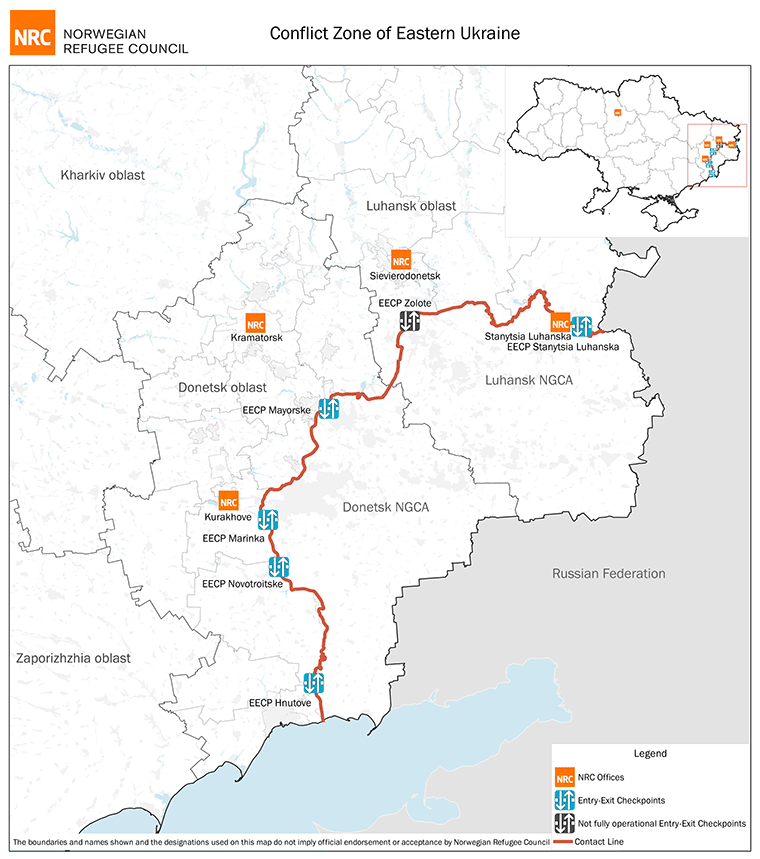Here are five things you should know about the crisis:
#1 Defying dangers to see their families
In April 2014, hostilities broke out in eastern Ukraine. Since then, the territory has been split between government-controlled areas and non-government controlled areas. As a result, a once-integrated community is now divided by a 427-kilometre long front line, the so-called "contact line". There are five checkpoints across the contact line – four in the Donetsk region, and one lone, damaged bridge serving all of the Luhansk region.
Every month, around 1.1 million people cross the contact line, despite deadly risks of regular shelling, landmines and explosive remnants of war. They cross to visit their families, go shopping at markets, obtain documents or access essential state services such as health care, as well as to check on their property on the other side.
People are forced to wait at the checkpoints for hours, both in harsh winter conditions and under the scorching summer sun. Despite the considerable efforts made by the government and humanitarian organisations, checkpoints still lack basic services such as hygiene facilities, drinking water and first aid.

#2 More than 3,300 civilians have been killed
The hostilities take a heavy toll on civilians. Over 3,300 civilians have been killed and approximately 9,000 injured since the beginning of the conflict. More than 50,000 residential buildings on both sides of the contact line have been damaged or destroyed, in addition to schools, hospitals and water facilities.
Five years of active hostilities have left undetonated weaponry scattered throughout vast areas of the conflict zone. Ukraine ranks amongst the most severely affected places in the world in terms of casualties of landmines and other explosive remnants of war. Since the beginning of the conflict, 924 casualties related to mines and remnants of war have been recorded.
Large-scale mine contamination poses lethal risks to civilians, including to half a million children living within the 20-kilometre area on both sides of the contact line. It also limits conflict-affected people’s access to markets, health care, agriculture and winter heating supplies.

#3 Forced to make impossible choices
The protracted crisis has stretched people’s resources to a breaking point, with families losing their livelihoods and having no other option but to sell their belongings or reduce costly expenditures.
The higher level of unemployment than in other parts of the country and sharp economic deterioration force people in eastern Ukraine to make impossible choices on whether to buy food, medicine or send their children to school.
Weakened social protection systems, disrupted access to markets and suspension of social benefits severely affect those who are the most at risk, such as seniors, single parent households with children and people with disabilities. More than one million people, including those who are internally displaced, do not have regular access to food and need livelihood support.

#4 Lacking full and equal access to their rights
Conflict-affected people in eastern Ukraine don’t have full access to their rights.
Almost 700,000 pensioners are not receiving their pensions because of the restrictive policies linking payment of pensions to conflict-affected people with the requirement to register as an internally displaced person. A large number of such pensioners regularly face the risk of arbitrary suspension of their pensions, which constitute the only source of income for the majority of older people affected by the conflict.
In the Donetsk and Luhansk regions, which are currently not under the control of the Ukrainian authorities, close to 60 per cent of children do not have birth certificates issued by the Government of Ukraine. Likewise, close to 80 per cent of deaths that have occurred in these areas remain uncertified by the Ukrainian authorities.

#5 Lasting solutions for displaced people remain uncertain
An estimated one million people has been permanently displaced by the armed conflict.
With such large-scale displacement continuing for five years, internally displaced people need to be able to resume a normal life by returning home voluntarily, by voluntary resettlement or integration into host communities.
In a situation of a protracted displacement, the prospects for displaced people to integrate into local communities remain uncertain. With their resources stretched to the limit, many displaced families face discrimination and experience challenges in finding housing solutions and accessing services, as well as securing stable employment. The inability of internally displaced people to exercise their voting rights in local elections also remains a barrier to integration into host communities.




